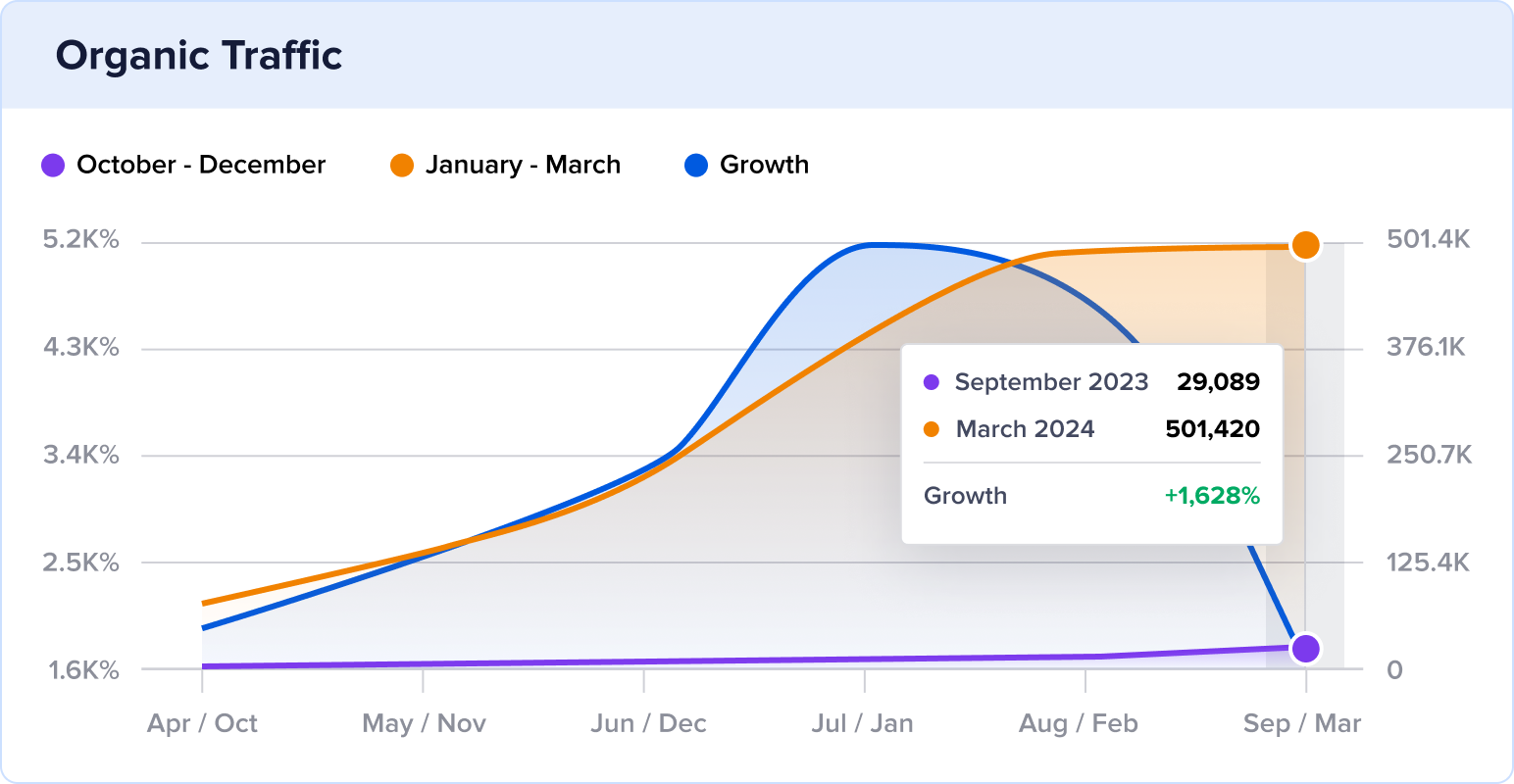How a Leather Goods eCommerce Grew Traffic by 322% in 6 Months
https://www.leatherology.com/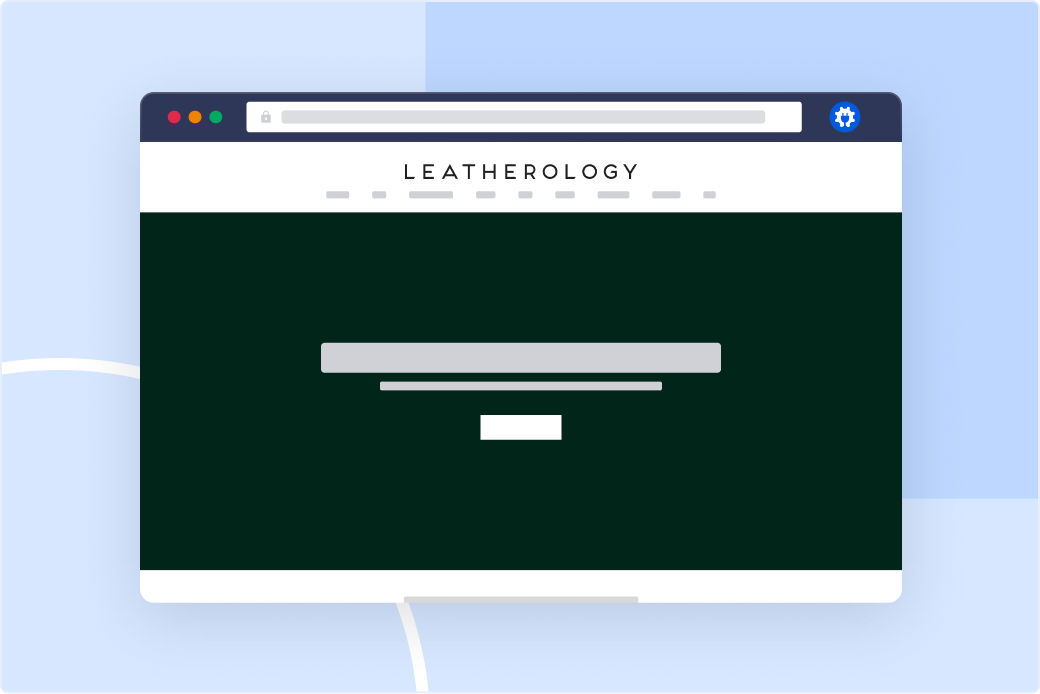
Stats
30.6K to 129K Monthly Visits
Industry
Ecommerce & Retail
Niche
Accessories
Reporting Date
January 2024
When running a business, trust is the cornerstone of success. It sets you apart from competitors, builds customer loyalty, and, ultimately, drives conversions.
It’s even more important for eCommerce, where customers have millions of merchants at their fingertips.
That’s why you need a strategy to stand out in search results.
Leatherology, a leather goods apparel, is a prime example of trust-building done right in eCommerce. Not only have they built a brand that customers love, but they’ve recently gotten the traffic to go with it—a remarkable 322% increase in just 6 months.
Let’s explore how they did it and uncover insights for your own online success.
In This Article
About Leatherology
Leatherology was founded in 2008 by sister-brother duo Rae and David Liu.
They specialize in leather goods and accessories, focusing on classic designs and simple silhouettes.
High-quality materials are sourced from around the world and at the core of each design.
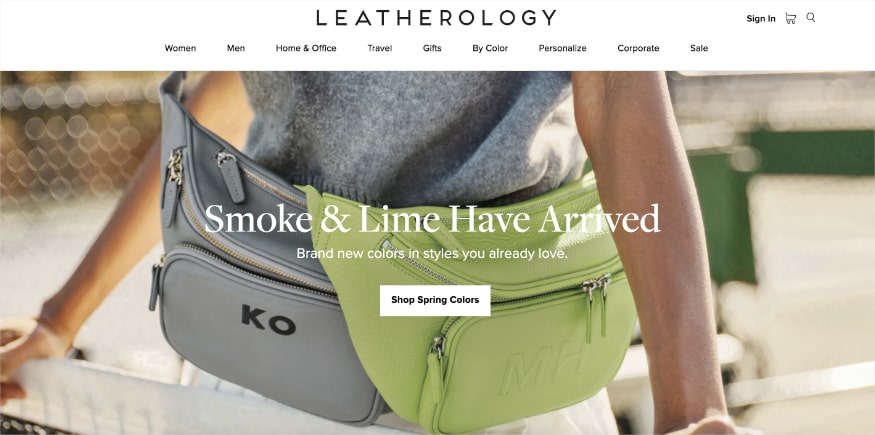
Today, despite being online only, Leatherology offers appointments by reservation at its headquarters in Carrollton, Texas.
They also ship internationally to Canada, Australia, Mexico, and select European countries.
Historical Performance
Leatherology launched in 2008, but for our analysis, we’ll start from January 2012, when Semrush historical data begins.
Here is a chart of their traffic over the past 12 years.

We can then break down this traffic into three periods to fully grasp Leatherology’s performance, making January 2024’s traffic all the more impressive.
The chart below shows these periods, their average monthly visits, and total traffic.
| Time Period | Average Monthly Visits | Total Organic Traffic |
|---|---|---|
| 2012–2015 | 1,275 | 61,206 |
| 2016–2019 | 18,532 | 889,541 |
| 2020–2023 | 36,783 | 1,765,572 |
| January 2024 | 129,016 | N/A |
Finally, it’s worth mentioning that 2020–2023’s traffic is largely influenced by the last few months of 2023. There were two significant traffic spikes in November and December.
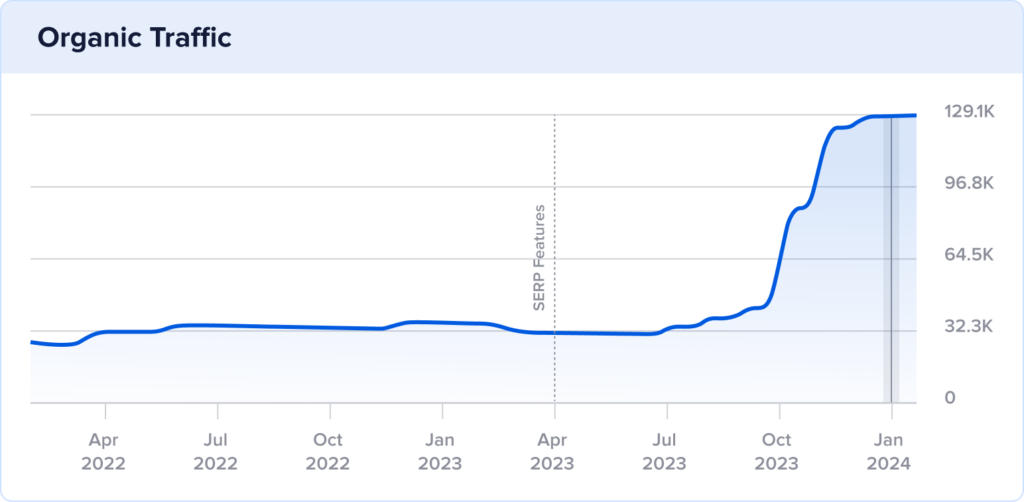
So, what exactly happened to unlock this new level of traffic and start 2024 off at unprecedented heights?
Let’s find out.
The Catalyst: How Leatherology Reached 129K Monthly Organic Visits
Leatherology grew its organic traffic by performing the following:
- Optimizing their SERP presence for product snippets
- Maintaining a blog and winning people also ask results
- Strengthening their linking strategy
We’ll explore each of these strategies in detail to understand how they contributed to Leatherology’s recent SEO success.
1. Optimizing Their SERP Presence for Product Snippets
One of the most remarkable transformations in recent months was the influx of new product snippets.
Product snippets are enhanced search listings that display product details right on the search engine results page (SERP). This can include information like price, availability, and customer ratings and reviews.
Here’s what one looks like on the SERP:
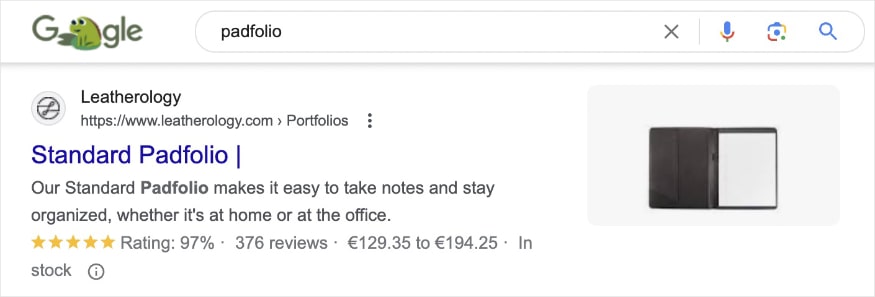
Between July 2023 and January 2024, Leatherology increased its product snippets by sixfold. They went from 4K to 24.1K rankings with this attention-grabbing rich result.
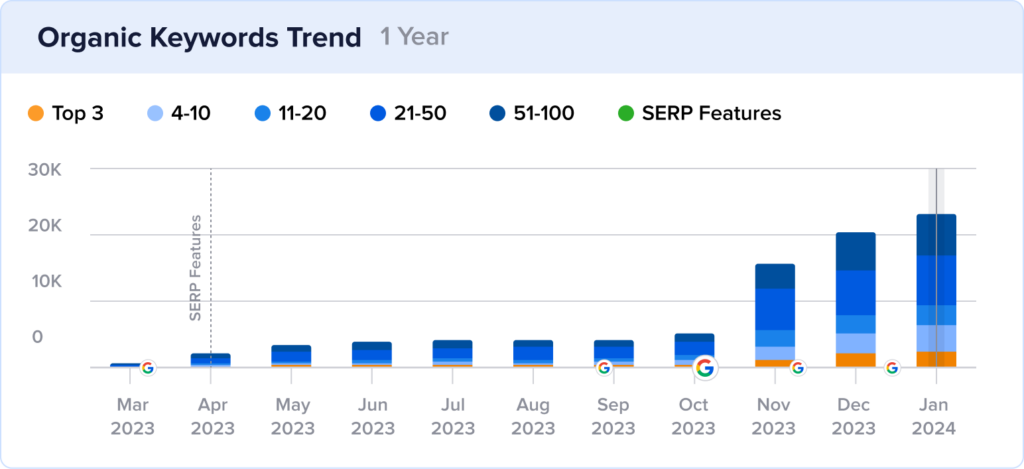
They also received organic product listings from Google Shopping, as shown below. These results require a Google Merchant Center account, which you can learn more about here.

So, these results are great, but how did they get them?
That’s the power of product schema markup (and a Google Merchant Center account for the former screenshot).
Leatherology uses schema markup to communicate with search engines in a way that’s easy for them to understand. Product schema is code that shares important details about your web page, which search engines can then use to generate a rich result on the SERP.
And while using schema markup doesn’t guarantee a rich snippet, it’s considered an SEO best practice and increases the likelihood.
Why this matters:
SEO statistics reveal that rich snippets have a higher clickthrough rate (CTR) than non-rich results.
Rich results receive 58% of all clicks, while standard listings have a 41% CTR.
What’s even more important about Leatherology’s rich snippets is the fact that they use product review schema to showcase customer reviews and star ratings directly on the SERP.
Product reviews are paramount to winning over new customers. They help:
- Build trust
- Provide social proof
- Encourage customer loyalty
- Drive sales
By consistently using schema markup on product pages, Leatherology has established a strong online presence and become a trusted leader in the leather goods realm.
How to get product snippets for your site:
As we saw, schema markup is integral to winning rich results. This tutorial demonstrates three methods for adding schema markup to WordPress without a plugin.
Each requires some coding knowledge and uses JSON-LD.
You can also read Google’s directions for implementing product structured data.
Finally, for Google Merchants, here are Google’s guidelines on how to set up structured data in Merchant Center.
Tools for product snippets:
Schema generator plugins are the easiest way to add schema markup to WordPress.
Plus, you don’t need any coding knowledge to use them.
All in One SEO (AIOSEO) has a Schema Generator that automatically formats structured data for you.
All you have to do is pick product from the Schema Catalog, then fill out your product details and reviews. That’s it!

Now, let’s see another clever way Leatherology is building its authority with the help of its blog.
2. Maintaining a Blog and Winning People Also Ask Results
Did you know that 56% of customers have purchased online after reading the company blog?
Blogs are a powerful way to connect with existing customers and reach a wider audience. They also allow you to show off your expertise, fostering credibility and authority in your niche.
At Leatherology, their blog is a key component of their SEO content strategy. Here, they share content that informs and resonates with their target audience.

For example, one of their top-performing blogs, “Monogram Etiquette 101: The Basics,” aligns with Leatherology’s monogramming services.
It also introduces their brand to new customers who may be interested in this service.
Furthermore, Leatherology’s use of question-based subheadings wins them increased visibility on the SERP.
Here’s why:
Google’s People Also Ask (PAA) section aims to answer users’ questions directly on the SERP.
By structuring their content in an FAQ style, Leatherology makes it easy for readers and search engines to find their answers.
Let’s look at an example.
Here’s the PAA box with a result from Leatherology:

And here’s the copy from the monogram blog:

They’re identical. (Keep in mind Google can alter or reorder the answer to better serve the user’s search.)
Ultimately, Leatherology caters to both users and search engines with these PAA-friendly blogs.
Why this matters:
There are several benefits to ranking in Google’s PAA box. Some of the most important include:
- Greater visibility
- Enhanced credibility
- Higher clickthrough rates
How to optimize your blog for PAA results:
Your content must be up to par to win these coveted rich results. High-quality content should always remain the focus of your optimization efforts.
With that said, there are steps you can take to optimize your content for PAA results:
- Perform keyword research and target question-based queries.
- Craft content that fulfills search intent.
- Add FAQ schema.
- Conduct a competitor analysis.
For a detailed explanation of each step, this tutorial tells you exactly how to optimize for Google’s PAA box.
Tools for PAA results:
AIOSEO has two tools to help you win PAA results: (1) Schema Generator and (2) TruSEO. You already learned how to add schema markup in the previous how-to (just pick FAQ this time!), so let’s focus on TruSEO.
The TruSEO tool analyses your content’s optimizations to help you maximize its reach. It runs a series of checks to generate action-oriented checklists.
For example, the Focus Keyphrase Checklist, as shown below, looks for your primary keyword in critical areas. If you’re writing question-based subheadings, like Leatherology, this tool will let you know when you forgot your keyword.
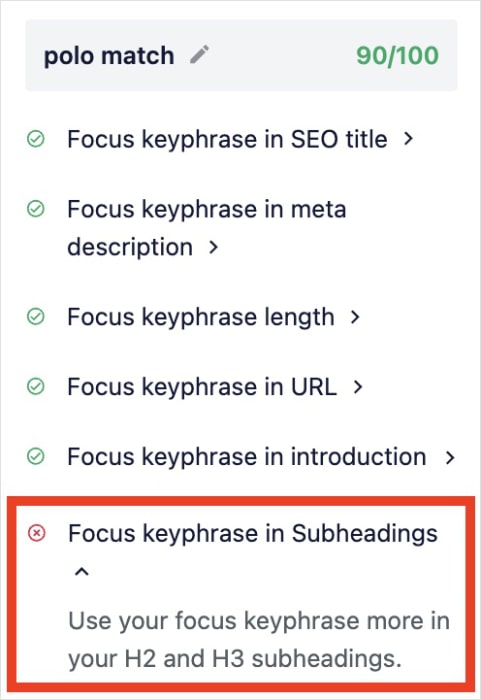
Next, let’s look at Leatherology’s linking strategy to see how it contributed to their recent growth.
3. Strengthening Their Linking Strategy
Link building is one of the pillars of successful SEO. It refers to the action of increasing the number of hyperlinks to your website.
There are three main types of links:
- Internal links – You send users from one page of your website to another.
- External links – You send users to another website.
- Backlinks – Another website sends users to you.
Let’s briefly review how Leatherology optimizes for all three.
1. Internal Links
Leatherology strategically includes internal links to pages across its website. You find them on the homepage, blogs, and collection and product pages.
Leatherology also uses two styles of sitemaps to further aid in internal linking and user navigation: a sitemap footer (as shown below) and a dedicated sitemap page.
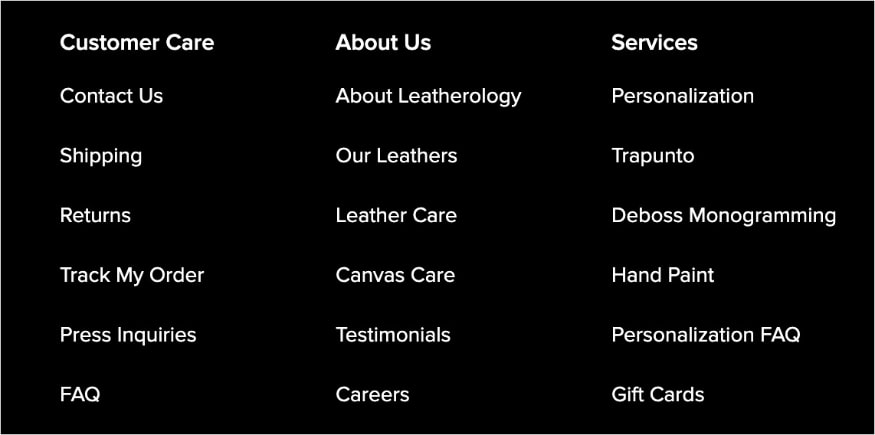
2. External Links
While the goal of any eCommerce is to keep users on the site, there are times when linking to an external website makes sense.
For example, Leatherology sometimes features other female entrepreneurs in its “A Day in the Life” blog series. In these posts, they may link to the featured company’s website and the entrepreneur’s social media accounts.
Leatherology also uses external links in the website’s footer to direct customers to their own social media profiles.
Tip: You can add all your favorite social media platforms to WordPress with AIOSEO’s social media integration.
3. Backlinks
As for backlinks, Leatherology has experienced significant growth in the past 6 months. They went from 38.2K in July to 62.2K in January.
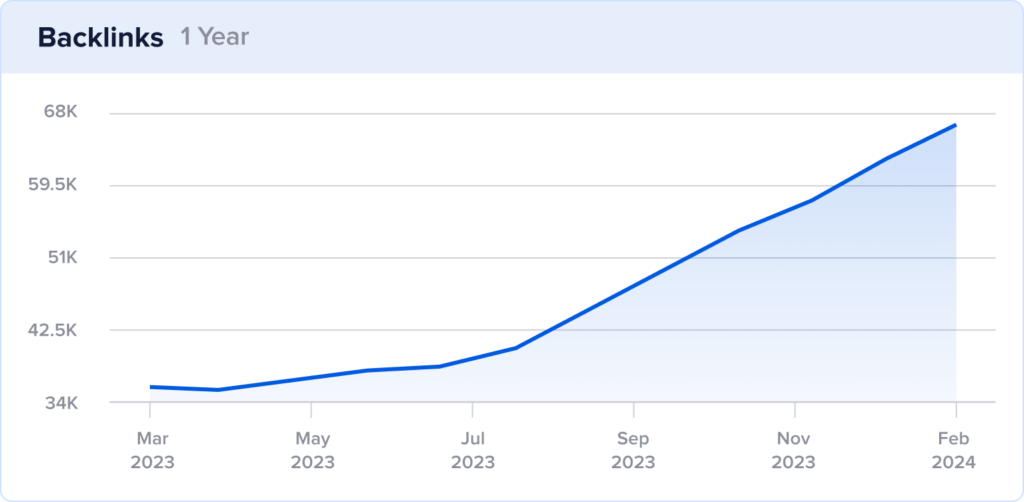
What’s noteworthy about these backlinks is their quality.
Leatherology has a strong, natural backlink profile. They come from credible, relevant sources like Who What Wear, Well + Good, and Real Simple.
They also use natural anchor text, which we can see in the backlinks below.

Why this matters:
Backlinks are among the top two ranking factors in 2024, making them an integral component of your SEO strategy.
By obtaining backlinks from credible sources within your industry, you earn trust among users and search engines. These endorsements boost your website’s authority and signal the reliability of your content.
It’s also important to remember that the best linking strategies are holistic. Leatherology excels at a strong internal linking strategy, which seamlessly guides users and search engines through the website.
How to do link building on your site:
This link-building guide shows you how to optimize for all three types of links.
We also recommend reading this backlinking guide to delve deeper into these powerful links.
Tools for link building:
Link Assistant is your ultimate companion for link building. With linking suggestions directly in the WordPress editor, it’s as simple as clicking Add Link.

Standout SEO Wins
Before we conclude, we’d like to highlight an additional technique at leatherology.com.
1. They control crawling with robots.txt.
Robots.txt is a text file that tells search engines which pages they can and cannot crawl. Leatherology uses this file to prevent crawling of pages with sensitive data (for example, customer account logins).
To prevent bots from accessing these areas of your site, you can set a disallow directive in your robots.txt file.
Tool: While it sounds technical, generating and editing a robots.txt file is easy with AIOSEO. The Robots.txt Editor allows you to add rules, like a disallow directive, in just a few clicks.

Takeaways
In our analysis of leatherology.com, we’ve seen how trust-building SEO strategies played a pivotal role in their recent success.
From earning credibility through backlinks to connecting with audiences via blog content, let’s explore which strategies you should adopt for your website and which ones may need reevaluation.
Top 3 Strategies to Emulate
- Use schema markup to earn rich snippets. Schema markup helps search engines understand your page and can lead to rich results on the SERP. Rich snippets attract more clicks than standard search listings, driving more traffic to your site.
- Create a blog to engage with your target audience. A blog is a valuable outlet for sharing informative and relevant content with existing and potential customers. By publishing blog posts that address their interests and questions. Blogs also help you boost brand awareness.
- Focus on building a strong linking strategy. Internal linking, external linking, and backlinking contribute to your website’s visibility. Internal links help users and search engines navigate your site. Eternal links enrich your content, and backlinks from credible sources improve your own authority. Optimize for all three to maximize your linking efforts.
Bottom 3 Strategies to Reconsider
- Omitting author bios in blog posts. Neglecting to include author bios is a missed opportunity to build credibility and engagement. Author bios provide readers with information about the writer’s experience and expertise, fostering authority and trust. These Google E-E-A-T elements play a significant role in 2024’s rankings. We recommend using the Author SEO tool to create and showcase powerful author bios on your website.
- Duplicating meta descriptions across multiple pages. While it may seem convenient to reuse the same meta descriptions, doing so can be confusing for users and search engines. Each page should have a unique meta description that reflects its content and encourages clicks. Take the time to craft compelling metadata for higher clickthrough rates and more organic traffic. You can also use a meta description generator to write them for you.
- Exceeding metadata character limits. When metadata exceeds the limited space on the SERP, it gets truncated. This can diminish their effectiveness, risking reduced clicks. Luckily, you can use a SERP preview tool to check metadata before publishing to see how it will look in search results.
Steal Our Winning SEO Strategy: A Checklist for Your Website
Do you want to boost your website’s visibility and join the winning ranks of websites like Leatherology?
Get your exclusive SEO Checklist for all the steps you need to climb the SERP and achieve organic success.
Download A Free SEO Checklist
Access our comprehensive SEO Checklist with a single click. We’ll deliver it straight to you, putting actionable items with SEO tools and tutorials right at your fingertips.
Enter your name and email to download a free SEO checklist.

Build Topical Authority and Earn Higher Rankings With AIOSEO
Even the strongest digital leaders have support.
With AIOSEO, you can streamline your SEO efforts and replicate the winning strategies discussed above with ease.
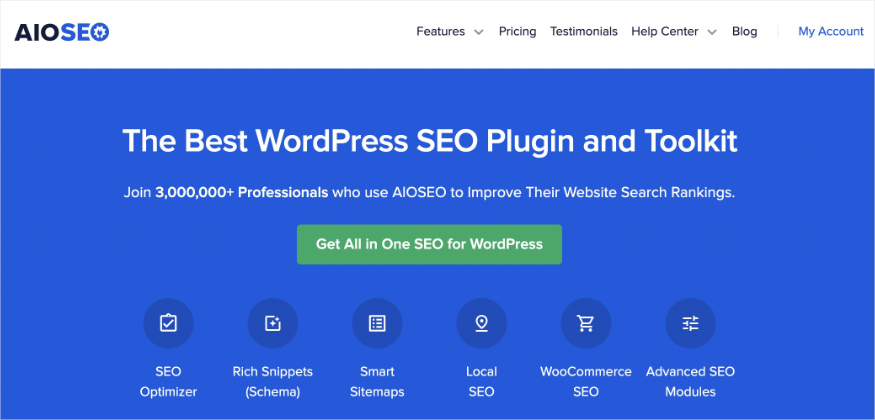
AIOSEO is the most powerful SEO plugin on the market. With thousands of 5-star reviews and trusted by over 3 million website owners, you’ll be in good company as you grow your rankings. You’ll get a traffic-winning suite of tools to help you take on the competition, boost your rankings, and establish authority in your niche.
Here are some of our favorite features:
- Rich Snippets Schema: AIOSEO offers various schema markup options to help you claim more rich results on the SERP. It’s as simple as choosing the schema you want; then, we’ll format the structured data for Google.
- TruSEO Score: Get a snapshot view, or go into detail, of your content’s on-page SEO with this innovative tool. TruSEO analyzes your content and gives you actionable insights to maximize its reach.
- Social Media Integration: Seamlessly connect your favorite social media platforms to your site and share content with your audience. Available integrations include Facebook, Instagram, Twitter, LinkedIn, Pinterest, YouTube, and more.
- Link Assistant: Get link suggestions, edit anchor text, and add internal links to your content in just 1 click. Link Assistant helps you effortlessly build a better linking strategy.
- Robots.txt Editor: Control how bots crawl your site with the Robots.txt Editor, which allows you to override default WordPress settings. This tool makes it simple to view your robots.txt file and manage rules.
- Author SEO: Create powerful author bios that showcase your experience and expertise. This addon aligns your content with Google E-E-A-T guidelines and helps readers trust what you’re sharing.

